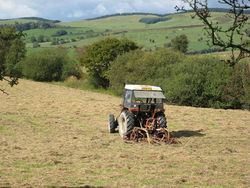Population 467 (2011) Country Wales Postcode district SY22 | OS grid reference SJ 0816 Sovereign state United Kingdom | |
 | ||
Llanfihangel-yng-Ngwynfa was a parish within the former historic county of Montgomeryshire. It now forms a major part of the Community Council area of Llanfihangel in Powys, which covers an area of 5,366 hectares (20.72 sq mi). Llanfihangel yng Ngwynfa Community Council covers Dolanog, Llanfihangel yng Ngwynfa and Llwydiarth with approximately 413 registered voters (as at 2012). The parish originally consisted of the following townships: Cefncleisiog, Cydwnfa, Dolwar, Fachwen, Farchwell, Fynnonarthwr, Garthucha, Halfen, Llaethbwlch, Llwydiarth, Nanty-Candy, and Rhiewlas. Dolanog was formed as a separate parish out of part of Llanfihangel in 1856.
Contents
- Map of Llanfihangel UK
- The Village
- Fair Llan
- Demographics
- Governance
- Life in a Welsh Countryside
- Literature
- References
Map of Llanfihangel, UK
The poet and hymnwriter Ann Griffiths (1776–1805) was born in Llanfihangel-yng-Ngwynfa and is buried there.
The Village
The main village is on road leading up to St Michael’s Church. It is situated just off the main Llanfyllin to Llanwddyn road, to the northwest of Welshpool. The church is no longer used, as it is unsafe. On the outskirts is the cemetery, a council estate of six houses, and a couple of privately owned bungalows. There is The Goat Inn at the centre, a post office/shop and the village hall, opened in 1981 and now the 'hub' of the village. A war memorial is at the centre of the village, and behind it is Poplar Cottage, once the home of E. D. O'Brien (1911-1953), a noted Eisteddfod conductor.
Fair Llan
A fair, known as Ffair Llan, used to be held every year on 9 May, when store cattle and sheep were sold to visiting dealers. Piglets were brought by horse and cart, with a mesh strung over to prevent their escape.
Demographics
Llanfihangel community's population was 467, according to the 2011 census; a 9.50% decrease since the 516 people noted in 2001.
The 2011 census showed 52.6% of the population could speak Welsh, a fall from 65.0% in 2001.
Governance
An electoral ward in the same name exists. This ward had a population of 1,049 at the 2011 census.
Life in a Welsh Countryside
In 1950 Life in a Welsh Countryside, A Social Study of Llanfihangel yng Ngwynfa by Alwyn D. Rees was published. This was soon recognised as a classic study of the social structure and life in a predominantly Welsh speaking rural community in an upland area of Wales. This study describes the farms of the area, kindred relationships, customs and traditions, and the role of religion, particularly the chapels. In 2003 the Llanfihangell Social History Group published Welsh Countryside: Revised: A new study of Llanfihangel yng Ngwynfa, which compares the changes that have taken place since the original publication, the decline in chapel attendance and the use of the Welsh language, which is now only spoken by slightly over half of the people in the village.
